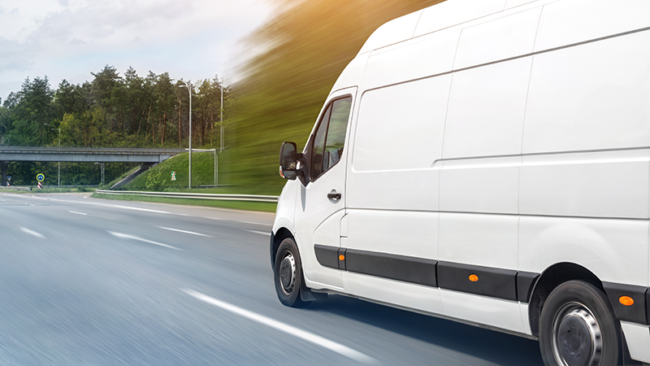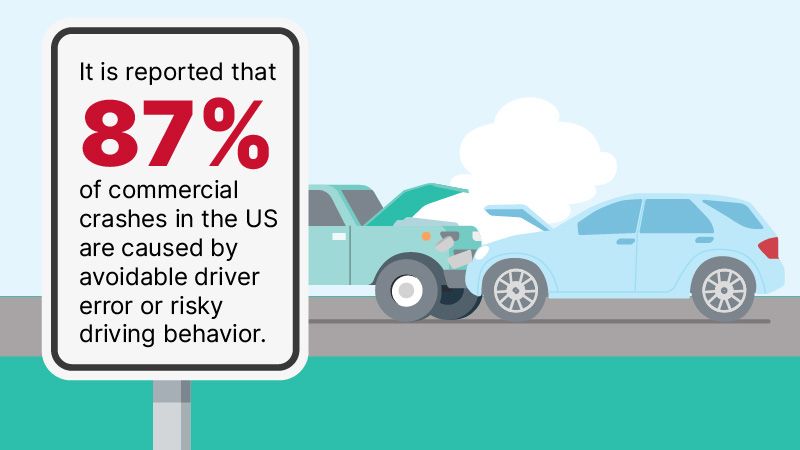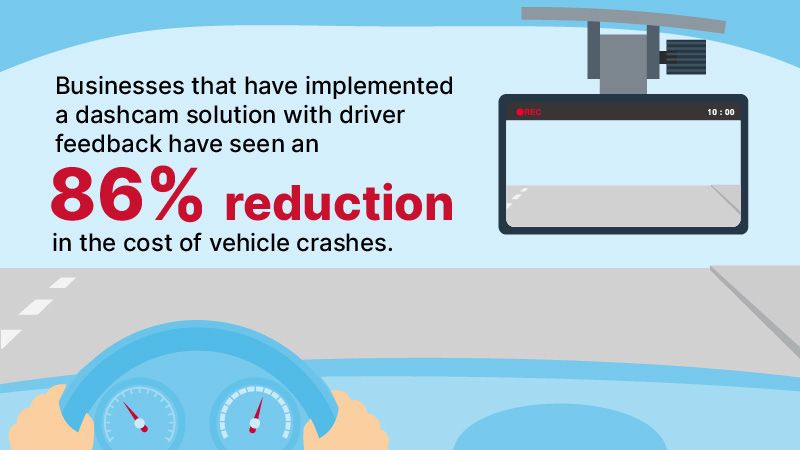Stay connected
Subscribe to our fleet blog and follow us on social media to receive all our fuel and energy industry insights.

Using the latest in edge computing technology, dash cams serve as vigilant guardians of both the road ahead and your drivers. While continuously capturing video, these cameras are designed to alert fleet managers during any high impact incident, including accidents. This selective notification system helps you prioritize and address the most significant events quickly. The footage captured by these dash cameras is invaluable, safeguarding a business’s two most precious resources: their drivers and their vehicles. These advanced tools offer essential insights, significantly enhancing the protection of drivers and overall business operations against risk.
NSTSCE reports that 87% of commercial crashes in the US are caused by either avoidable driver error or risky driving behavior. With a dash camera installed, track driver performance, recognize distracted driving, and capture a record of what happened both at the front of the vehicle and in the cab. These records provide highly reliable insights and will help you identify and put into play new efficiency and safety practices.

Dash cameras come with a variety of bells and whistles, and the benefits of these tools increase when they’re integrated into an existing telematics solution. Coupled with telematics, a dash camera provides fleet managers with a view into critical events and risky behaviors. Pairing the two gives you more video evidence and better oversight of your daily operations. Essentially, you are pulling more vital data about your operations out of one application.
A good example of the value of a dash camera paired with telematics is the visibility you get into the driver’s breadcrumb trail as he goes about his daily route. A fleet manager can select instances during a driver’s day where critical moments have occurred on the road and then review video of those moments within the application. When a driver is on their phone or not paying attention to the road, distracted driving can be detected by the in-cab camera. If distracted driving or a driver mistake results in a collision, a fleet manager will have more evidence to determine fault, liability, and make decisions on how to reduce the possibility of another accident. A dash camera coupled with a telematics tool will help your business avoid costly and sometimes dangerous accidents.
In-vehicle cameras help businesses decrease risk by gathering insights on driver behavior. These insights can help fleet managers coach drivers: managers can give real-life examples to encourage better performance. In-cab cameras used with a telematics solution will offer real-time alerts to your drivers allowing them to recognize risky behavior as it occurs and make the necessary behavioral corrections.
Positive reinforcement is a great tool to help build driver confidence and improve performance. There are a variety of dash camera solutions on the market, the best of which use positive reinforcement throughout the driver experience. A quality system will give the driver positive feedback.
Dash cameras are a game-changer for any business with commercial vehicles: their installation means you’ll likely see a reduction in your insurance premiums. With driver monitoring and an increased ability to determine accountability in accidents, some insurers require dash cameras to be installed for all fleets as a precautionary measure. The proliferation of dash cam use is a growing trend in the marketplace that we don’t anticipate letting up. The reason being these cameras benefit both fleet owners and insurance companies. For companies that don’t see a benefit to installing dash cameras for their entire fleet, there is the option to single out at-risk drivers for dash camera installation, promoting safer driving due to closer driver observation.
The Federal Motor Carrier Safety Administration states that businesses pay an average of $90K per incident involving their drivers. Dash camera video footage can be used as evidence in the case of a crash or accident. On-board cameras typically have two camera views. One view shows what is occurring inside the vehicle and the other is looking out at the road from the driver’s perspective. Having proof of who is at fault in a collision can be extremely valuable especially when it means protecting good drivers who were not at fault.
In the case of a critical event or accident, your fleet management software ideally collects all the data from the vehicle at the time of the incident. When in-cab video is partnered with a quality telematics application the insights surrounding an accident expand to include what occurred both before and after the event. Precise vehicle routes, diagnostics, and operator behavior are readily available to the fleet manager. Of course, dash cameras enhance this data set with 30-second video before and after the incident. The video includes both points of view (inside the cab and driver view of the road) and video is uploaded to your cloud-based telematics application. This is another example of how dash cameras and telematics can work together to create a valuable user experience.
Dash cameras can protect your drivers and business from unnecessary risks and provide valuable driver insights. The Journal of Safety Research states that businesses that have implemented a dashcam solution with driver feedback have seen an 86% reduction in the cost of vehicle crashes.

Drivers responsible for operating a company vehicle experience the stress of knowing an accident could happen at any moment. If an accident does occur and the fleet driver is not responsible, they can be confident knowing their dash camera will provide accurate evidence of what occurred during the collision. According to the National Insurance Crime Bureau, commercial vehicles are often targeted in insurance fraud accidents. Perpetrators prey on what they perceive to be new vehicles, rental cars, or commercial vehicles because those classes of vehicles tend to be well-insured. Dash cameras are a useful tool in these situations, as they provide evidence of what was happening on the road and in the cab at the time, and capture video evidence to protect high performing drivers, placing accountability on the correct party.
A high quality system will incorporate valuable insights and establish a driver scorecard. Based on performance, a driver can then see the improvement they are making over time. These scorecards act as a powerful incentive for fleet drivers to improve performance. Fleet managers can share each driver’s score with the whole crew to encourage a safety-conscious culture on the team. These simple scorecards help drivers understand where they rank compared to other drivers and encourage them to improve their driving practices.
Efficient and effective fleet management solutions are vital tools that can help ensure smooth business operations. Fuel cards that are integrated with a quality telematics solution provide a combination of technology, data analytics, and customer service to ensure your fleets run safely and efficiently. Adding a dash camera to your tool kit enhances your fleet management solutions and decreases operating costs in the long run. Dash cameras need to be integrated with your telematics solutions in order to provide the most efficient and effective results.
There are many dash camera solutions in the marketplace today. When researching which dash camera makes the most sense for your business, it’s ideal to work with a fleet card provider to help you navigate what can be a complicated process. It’s important to start the discussion with the challenges you’re currently facing. Your fleet card provider can then review multiple options by weighing pros and cons and offer demonstrations of dash cameras before you buy. As subject matter experts, your fleet card partner can help you understand every aspect of the solution before making a decision. This includes camera functionality, integration options, vehicle installation options and pricing.
In addition to finding the right solution, companies need to identify a fuel card partner to help support their ongoing needs. We recommend exploring the different ways each potential fleet partner approaches customer support and ongoing terms of service. It can be useful to invite them to help you solve complex problems related to fleet management. This inclusive approach can help ensure you interpret insights accurately and maximize your return on investment. At WEX, we have a team that provides customer support and educational services on how to use these products and the accompanying technology. These efforts help ensure our customers have a great experience with our easy-to-use, reliable tools.
With the advancement in dash camera technology, fleet managers can now make data-informed decisions that will protect and enhance your business. Adding dash cameras to your fleet will save money on incident-related costs and reduce overall operating expenses. This technology has a significant return on investment and can be seamlessly integrated into your existing fleet card solutions. WEX has prioritized its customers’ needs to find top tier dash cameras with the best features at competitive prices. We hope that you will invite us to help you adopt these tools into your business.
To learn more about WEX, a dynamic and nimble global organization, please visit our About WEX page.
Editorial note: This article was originally published on June 7, 2023, and has been updated for this publication.
Resources:
NSTSCE
Journal of Safety Research
Security Bros
Samsara
National Insurance Crime Bureau
Automotive Fleet
Federal Motor Carrier Safety Administration
Subscribe to our fleet blog and follow us on social media to receive all our fuel and energy industry insights.